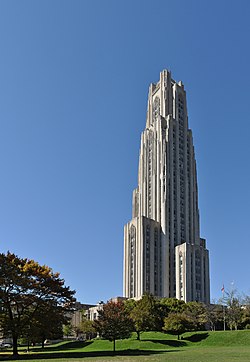
Back كاتدرائية التعلم ARZ Cathedral of Learning Catalan Cathedral of Learning German Cathedral of Learning Spanish Cathédrale de l'Apprentissage French קתדרלת ההשכלה HE Cathedral of Learning IG Cathedral of Learning Italian 学びの聖堂 Japanese Cathedral of Learning Dutch
Cathedral of Learning | |
 The Cathedral of Learning at the University of Pittsburgh | |
| Location | Pittsburgh, Pennsylvania, USA |
|---|---|
| Coordinates | 40°26′39″N 79°57′11″W / 40.44417°N 79.95306°W |
| Built | 1926 |
| Architect | Charles Klauder |
| Architectural style | Late Gothic Revival with some Art Deco influences |
| Part of | Schenley Farms Historic District (ID83002213) |
| NRHP reference No. | 75001608[1] |
| Significant dates | |
| Added to NRHP | November 3, 1975[1] |
| Designated CP | July 22, 1983[1] |
| Designated CPHS | February 22, 1977[2] |
| Designated PHLF | 1970: Croghan-Schenley Ballroom[3] 1972: Cathedral of Learning interiors[4] 1973: Cathedral of Learning[5] |
The Cathedral of Learning is a 42-story skyscraper that serves as the centerpiece of the University of Pittsburgh's (Pitt) main campus in the Oakland neighborhood of Pittsburgh, Pennsylvania. Standing at 535 feet (163 m),[6] the 42-story Late Gothic Revival Cathedral is the tallest educational building in the Western Hemisphere and the second-tallest university building (fifth-tallest educationally purposed building) in the world, after the main building of Moscow State University.[7] It is also the second-tallest gothic-styled building in the world, after the Woolworth Building in Manhattan.[8] The Cathedral of Learning was commissioned in 1921 and ground was broken in 1926 under general contractor Stone & Webster.[9] The first class was held in the building in 1931 and its exterior finished in October 1934,[10] prior to its formal dedication in June 1937. It is a Pittsburgh landmark[2][11] listed in the National Register of Historic Places.[12][13]
Colloquially referred to as "Cathy" by Pitt students,[14][15] the Cathedral of Learning is a steel-frame structure overlaid with Indiana limestone and contains more than 2,000 rooms and windows. It functions as a primary classroom and administrative center of the university, and is home to the Dietrich School of Arts and Sciences, the School of Social Work, and many of its departments, as well as the Frederick Honors College. It houses many specialty spaces, including a studio theater, food court, study lounges, offices, computer and language labs, 31 Nationality Rooms, and a half-acre (2000 m2, 22,000 ft2), 4-story-high, vaulted, gothic study and event hall. The building contains noted examples of stained glass, stone, wood, and iron work and is often used by the university in photographs, postcards, and other advertisements.
- ^ a b c "National Register Information System". National Register of Historic Places. National Park Service. July 9, 2010.
- ^ a b "Pittsburgh History and Landmarks Foundation: Local Historic Designations". May 1, 2002. Retrieved February 25, 2008.
- ^ "Historic Landmark Plaques 1968-2009" (PDF). Pittsburgh, PA: Pittsburgh History & Landmarks Foundation. 2010. p. 3. Retrieved June 25, 2010.
- ^ "Historic Landmark Plaques 1968-2009" (PDF). Pittsburgh, PA: Pittsburgh History & Landmarks Foundation. 2010. p. 5. Retrieved June 25, 2010.
- ^ "Historic Landmark Plaques 1968-2009" (PDF). Pittsburgh, PA: Pittsburgh History & Landmarks Foundation. 2010. p. 6. Retrieved June 25, 2010.
- ^ "Cathedral of Learning, Pittsburgh, U.S.A." Emporis. Archived from the original on August 20, 2004. Retrieved August 2, 2010.
- ^ "Moscow State University, Moscow, Russia". Emporis. Archived from the original on April 6, 2004. Retrieved August 2, 2010.
- ^ "Cathedral of Learning, Pittsburgh". SkyscraperPage.com. Retrieved December 7, 2012.
- ^ "C. A. Stone Is Dead" (PDF). DailNew York Times Obituaries, page 21. February 26, 1941. Retrieved July 9, 2019.
- ^ Alberts, Robert C. (1986). Pitt: The Story of the University of Pittsburgh, 1787-1987. Pittsburgh, PA: University of Pittsburgh Press. p. 129. ISBN 978-0-8229-1150-0. Retrieved November 10, 2009.
- ^ "Internet Archive: Pittsburgh History and Landmarks Foundation: PHLF Plaques & Registries". January 27, 2007. Archived from the original on January 27, 2007. Retrieved February 25, 2008.
- ^ "National Register of Historical Places - PENNSYLVANIA (PA), Allegheny County". National Register of Historic Places. National Park Service. Retrieved August 2, 2010.
- ^ "National Register of Historic Places Inventory - Nomination Form: Cathedral of Learning" (PDF). 1967. Retrieved June 8, 2010.
- ^ Iacullo, Jessica (April 15, 2014). "YouTube sensations perform at Bigelow Bash". The Pitt News. Retrieved March 5, 2016.
- ^ Schackner, Bill (March 4, 2016). "Pitt's "Cathy" gets people chatty about nickname". Pittsburgh Post-Gazette. Pittsburgh, PA. Retrieved March 5, 2016.


